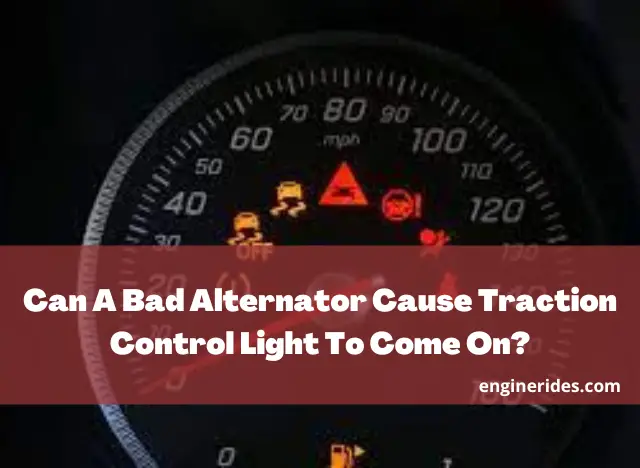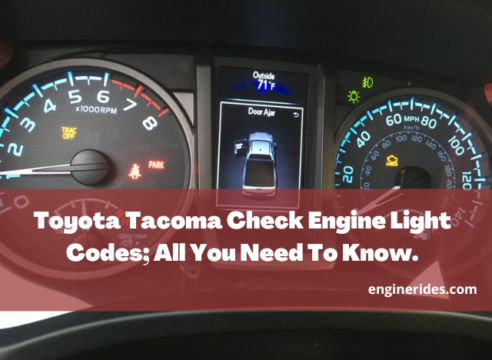Can A Bad Alternator Cause Traction Control Light To Come On?
Can a bad alternator cause the traction control light to come on in a vehicle? We’ll examine the role of the alternator in a car’s electrical system, how it can potentially impact traction control systems, and the symptoms of a failing alternator.
This guide aims to demystify the connection between these two seemingly unrelated car issues, using simple and straightforward terminology for easy understanding.
What is the Function of an Alternator in a Vehicle?
The alternator plays a crucial role in a vehicle’s electrical system. It is responsible for charging the car battery and powering the electrical system while the engine is running. Essentially, the alternator converts mechanical energy into electrical energy.

This electrical power is vital for running various components, including the ignition system, headlights, and the car’s computer systems, which include the traction control system.
A healthy alternator ensures that all these systems receive a steady supply of electrical power. When the alternator is functioning properly, it maintains the battery’s charge and ensures that all electrical components have the power they need to operate effectively.
Can a Failing Alternator Affect the Traction Control System?
Yes, a failing alternator can indirectly affect the traction control system. The traction control system relies on various sensors and the car’s computer to function correctly.
These components require a consistent electrical supply, which is provided by the alternator when the engine is running. If the alternator starts to fail, it may not provide enough power to these systems.
When the power supply becomes inconsistent or insufficient, the car’s computer systems, including the traction control, may not function properly. This can trigger the traction control light to illuminate on the dashboard. It’s a sign that the system is receiving inadequate power, which can affect its ability to monitor and control the vehicle’s traction.
What are the Symptoms of a Bad Alternator?
Identifying a failing alternator is key to resolving issues related to your vehicle’s traction control system.
Common symptoms of a bad alternator include
- dimming headlights,
- electrical issues,
- a dead battery,
- strange noises, and
- the illumination of the battery warning light on the dashboard.
If you notice that your car’s headlights or interior lights are dimming or flickering, especially at low speeds, it could be a sign that the alternator is not generating enough power.
Other electrical issues, such as malfunctioning accessories or erratic instrument panel displays, can also indicate a problem with the alternator. Additionally, if the battery dies frequently or you hear unusual noises (like grinding or whining) from the engine area, these could be signs of alternator troubles.
How Can I Test My Alternator?
To determine if a bad alternator is the cause of your traction control light coming on, you can perform a few tests.
A simple way to test the alternator is by starting the vehicle and running the headlights. If the lights brighten as the engine revs up, this could indicate that the alternator is not providing a consistent power supply at lower RPMs.
Another method is to use a voltmeter to check the battery voltage. With the engine off, a healthy battery should read around 12.6 volts. When the engine is running, the voltage should be between 13.7 to 14.7 volts, indicating that the alternator is charging the battery. If the voltage doesn’t increase when the engine is running, this could signify an alternator issue.
Toyota Camry Traction Control Light Stays On; Cuases, Diagnosing And Fixing
ENGINERIDES.COM
What Should I Do if My Alternator is Failing?
If you suspect that your alternator is failing, it is important to address the issue promptly.
Driving with a bad alternator can lead to a drained battery, leaving you stranded. Additionally, it can cause other electrical systems in the car, including safety features like traction control, to malfunction.
The best course of action is to have your vehicle inspected by a professional mechanic. They can perform a thorough diagnosis to confirm whether the alternator is the problem and advise on the necessary repairs or replacement. In some cases, the alternator can be repaired, but often a replacement is the more reliable solution.
What else can cause traction control light to come on?
The traction control light illuminating on your dashboard can be triggered by several issues beyond a bad alternator. It’s important to understand that the traction control system works to prevent wheel slip and maintain vehicle stability, and various factors can affect its operation. Here are some common causes for the traction control light to come on:
01. Wheel Speed Sensors
Traction control systems rely on wheel speed sensors to determine if one wheel is spinning faster than the others. If these sensors are faulty, dirty, or damaged, they can send incorrect signals, causing the traction control light to turn on.

02. Malfunctioning ABS (Anti-lock Braking System)
Since the traction control system often shares components with the ABS, issues with the ABS, such as a faulty ABS sensor, can trigger the traction control light.
03. Poor Road Conditions
Sometimes, the traction control light may come on temporarily when driving on slippery or uneven surfaces. This is typically normal and indicates that the system is active.
04. Tire Issues
Mismatched tires, Overinflated tires, or worn tires can lead to discrepancies in wheel speed readings, affecting the traction control system.
05. System Errors
General malfunctions or errors within the vehicle’s computer systems, such as software glitches or communication issues between modules, can cause the light to come on.
Can Bad Alignment Cause The Traction Control Light To Come On?
ENGINERIDES.COM
06. Steering Angle Sensor
This sensor monitors the steering wheel’s position and rate of turn. If it’s not functioning properly, it can affect the traction control system.
07. Faulty Brake Switch
A brake switch that isn’t working correctly can send wrong signals to the traction control system, leading to the light being activated.
08. Wiring Issues
Faulty or damaged wiring in any part of the traction control system can lead to malfunctions.
When the traction control light comes on, it’s usually a sign that the system is disabled or has detected a problem. While sometimes it may be a temporary issue that resolves itself, if the light stays on, it’s advisable to have your vehicle checked by a professional. They can use diagnostic tools to read the error codes from the car’s computer and pinpoint the exact cause of the issue.
Some Related FAQs,
Q1: Can an alternator issue cause other warning lights to illuminate?
Yes, a failing alternator can cause various warning lights, such as the battery light, check engine light, or even the ABS light, to come on due to insufficient power supply.
Q2: How long does an alternator typically last in a vehicle?
The lifespan of an alternator can vary, but typically it lasts about 7 years or 100,000 to 150,000 miles, depending on vehicle and usage conditions.
Q3: Can jump-starting my car frequently damage the alternator?
Frequent jump-starts can strain the alternator as it works hard to charge a weak battery, potentially leading to premature wear.
Q4: Are there any maintenance tips to extend the life of my alternator?
Regularly checking the battery condition, ensuring the alternator belt is in good shape, and keeping electrical connections clean can help extend the life of your alternator.
Q5: Is it safe to drive with a bad alternator?
It’s not advisable to drive with a failing alternator, as it can lead to a dead battery or malfunction of critical systems, potentially leaving you stranded or compromising vehicle safety.







